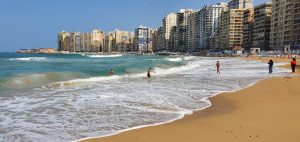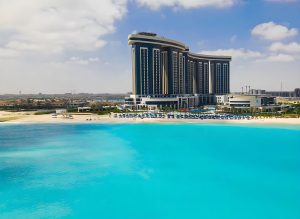Alexandria – Dr. Gamal El Magayda:
The Rixos Hotels and Resorts Egypt organized a tour for us in the city of Alexandria to explore its historical, touristic, and cultural landmarks, as well as its beautiful beaches along the Mediterranean coast.
The purpose of the tour is to provide a realistic picture for visitors of Rixos Premium Alamein and Rixos Alamein on the northern coast of Alexandria about the historical and touristic treasures the city holds.
Every time I visit this city, I discover a new beauty in this charming Mediterranean city. It’s a city that reminds you of the grandeur of ancient Rome and the splendor of Athens.
In Alexandria, history blends with civilization, beauty with the azure sea, and the kindness of its people who greet visitors with smiles. Visitors can sense the traces of human civilizations since the era of the Greeks and Romans, enjoying the remnants of these ancient relics in museums, castles, and scenic spots that visitors and locals alike witness every new day with the sunrise.
The sea is Alexandria’s lung and the source of life. It has inspired its residents and visitors, celebrated by poets and written about by writers from Arab and foreign lands. However, the beaches require a bit of effort for general cleanliness and maintaining the beauty of the sea. The Corniche road needs government intervention to reduce environmental and noise pollution from car emissions and excessive use of warning sirens!
Alexandria is renowned for its beautiful extended beaches and wide corniche. Its top four beaches are Stanley Beach, Montazah Beach, Al-Ajami Beach, and Al-Maamoura Beach. Abu Qir is a small fishing town where you can enjoy delicious seafood and the beautiful sun, along with fishing as a hobby.
Alexandria occupies a unique geographical location on the Mediterranean coast between three ancient continents: Africa, Asia, and Europe. Perhaps this location has given it all this charm and distinction over the ages!
It is Egypt’s second capital and houses treasures of ancient civilizations, blessed with rare nature and moderate weather year-round. Its history extends over five thousand years and includes dozens of modern and ancient tourist attractions, including mosques, churches, castles, museums, and Pharaonic, Greek, and Islamic antiquities, as well as old markets, magnificent palaces, and lush gardens. One of its prominent civilization icons is the Bibliotheca Alexandrina, recently rebuilt to become a global cultural and civilizational landmark.
Freshwater and Saltwater Alexandria is a city where freshwater and saltwater meet, as it receives freshwater from the Nile River through Mahmoudiya Canal that runs through the city, and saltwater from the Mediterranean. Not to mention the warmth and hospitality of Alexandrian faces.
Alexandria is located on the western corner of the Egyptian Delta. It was planned by Alexander the Great when he invaded Egypt in 333 BC, although he died before seeing it. The Greek city plan remained throughout the Roman era. In the Islamic era, which began with the conquest of Egypt by Amr ibn al-As in 642 AD, the city became a destination for many scholars, imams, and righteous people. Like the Acropolis in Greek architecture, the mosque became the centerpiece of the city, and its streets lead to it.
Ibn al-Hakam, the author of the oldest historical text we have about the mosques of Alexandria, says there are five mosques: the Mosque of Prophet Moses, the Mosque of Prophet Solomon, the Mosque of Dhu al-Qarnayn (or Al-Khidr), the next mosque at the eastern gate of the city, and the fifth being the Mosque of Amr ibn al-As.
Alexandria has a significant tourism status, perhaps uniquely combining all tourist products that tourists seek. Culturally, Alexandria is an open museum dating back to 331 BC, passing through Greco-Roman, Christian, Islamic, and modern eras.
Home of Civilizations! Alexandria combines Roman and Coptic civilizations, with many Greek landmarks. Alexandria is famous for its beautiful extended beaches along the city’s length and its stunning sea views. Every inch in Alexandria is very distinctive. Edward M. Forrester said, “The best way to see Alexandria is to wander aimlessly.”
The Roman Theater is one of the most important tourist attractions visited by tourists. This ancient theater is located in Kom El-Deka, dating back to the 2nd century AD, restored in the 4th century AD. It was discovered in modern times in 1960 and is now the only Roman theater in Egypt, taking about 30 years to excavate, containing 800 marble seats and mosaic flooring.
Visitors also enjoy visiting the Catacombs, dating back to 250 BC, which depict the daily life of Egyptian gods, decorated with marble and marble. We also visited the Catacombs, which are ancient tombs dating back to the 2nd century BC, containing the statues of King Sobek and Anubis wearing Roman armor.
In Qaitbay Citadel! I spent long hours wandering through the Qaitbay Citadel, sometimes with the tour guide who never stopped explaining, sometimes alone, and sometimes with friends. There, on the rooftop of the historic citadel, the heart and soul are set free to inhale the sea breeze blowing with cold air.
This fortress was built specifically to fortify the city against invasion from the land. It was built by Sultan Al-Ashraf Qaitbay in 1477 AD and is located at the eastern end of the old Pharos Island, consisting of a large tower supporting each corner with a small round tower.
The Roman and Greek Museum covers a long period from the 3rd century BC to the 7th century AD, casting its diverse shadow over Alexandria. There emerged a class that rejected local spiritual development, known as Serapis, a mix of Greek, Roman, and Pharaonic religions.
As for the Royal Jewelry Museum in the Glim suburb, it contains the personal jewelry collection of Mohamed Ali Pasha.
Alexandria: Egypt’s Most Important Port Due to its location and natural features, Alexandria has become Egypt’s most important port and one of the top three ports in the Mediterranean basin, the largest port in the Eastern Mediterranean and the Middle East. Therefore, the city gained its fame as a summer resort for residents of the country during the summer months. The Alexandria Governorate also works to open up tourism opportunities throughout the rest of the year, thanks to the city’s moderate climate, attractive beaches, and unique historical and touristic landmarks.
Prominent Geographic Features in the City – the Eastern Port with its crescent shape, bordered on the east by the Seashell area and on the west by Ras, which ends with Qaitbay Citadel, one of the city’s archaeological landmarks. To the west, there is Ras El Tin area, characterized by Ras El Tin Palace and its private gardens.
As for the eastern part of the city, after passing many of Alexandria’s beaches along the Corniche, visitors find themselves in the gardens and Montazah Palace, a distinguished tourist center.







